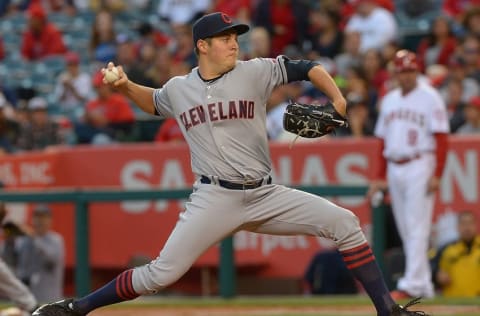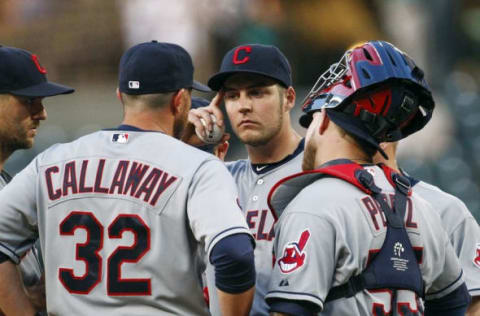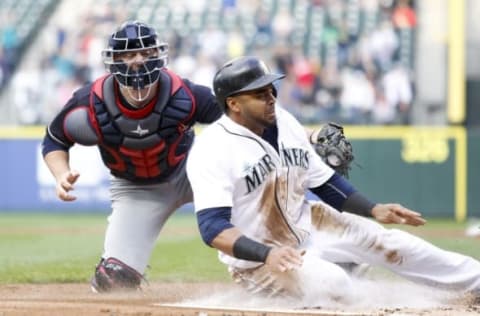Cleveland Indians: Trevor Bauer Has Turned the Corner


The Cleveland Indians are in first place due in large part to the strength of their pitching staff, and Trevor Bauer is a big reason why. Has the right-hander finally put it all together?
Wednesday was a historic day in Cleveland, and I’m not talking about the epic parade and rally held for the NBA Champion Cavaliers. A 6-1 defeat of the Tampa Bay Rays by the Indians at Progressive Field capped off the first month in franchise history that the team went undefeated at its home ballpark.
The Tribe went a perfect 11-0 at home in June, and it was fitting that the last of those wins was delivered by the man that started the streak: Trevor Bauer. Long a mystery wrapped in an enigma, the former No. 3 overall pick in the 2011 draft out of UCLA, who made his way to Cleveland in the Shin-Soo Choo trade, has confounded coaches and fans alike in parts of four big league seasons. While the stuff has always been evident, the question for Bauer has always been if he could get out of his own head long enough to use it.
The answer thus far in 2016 has been an emphatic yes, and it’s hard to figure the Indians would be perched atop the American League Central without that happening. After a strong spring that saw a sharp spike in velocity, Bauer nevertheless lost out to Cody Anderson for the fifth starter spot and began the season in the bullpen.
But a hamstring injury suffered by Carlos Carrasco on April 24th propelled him back into the starting rotation, and he has responded in a big way. After Wednesday’s complete game in which he yielded just one run on three hits while striking out 10 and walking only one, Bauer has tallied six consecutive quality starts covering 44.2 innings. During that stretch, his earned run average has been just 2.22, and has allowed a meager 11 walks and one home run.
In five June starts, each of which has lasted at least seven innings, that ERA plunges to 1.67. The Tribe is 4-1 in those outings, with the lone defeat coming in walk-off fashion against the Angels in Anaheim on June 11th.
“He’s been so consistent,” Cleveland Indians manager Terry Francona said after Wednesday’s game. “He’s pounding the strike zone with really good stuff, changing speeds. It’s been really fun to watch.”
Consistency has been Bauer’s achilles heel thus far in his pro career. Each of the last two seasons, he has finished up with his ERA and FIP over four, an ERA+ under 100, and a total of 3.0 bWAR. In 2015, his 79 walks allowed led the league.
This season he is 5-2 with an ERA of 3.20, an FIP of 3.28, an ERA+ of 142, and 2.5 bWAR in 84.1 total innings of work. As a starter, the numbers look even better, with a 2.96 ERA in 73 innings. Among qualified pitchers in the AL, Bauer currently ranks ninth in ERA and fourth in FIP.
So what’s brought on this turnaround? There are a few factors worth mentioning.
Next: Ease up on the gas.
Command Performance

At times in the past, Bauer has seemed more concerned with the number on the radar gun than with putting the ball where he wants it. While he has the arm to light it up at 97 miles per hour, sacrificing velocity, even a small amount, for better command seems to be having a positive impact on his ability to make quality pitches.
Using PITCHf/x data from Brooks Baseball, we can see that the average velocity of all of Bauer’s pitches has dropped since the season began. In the case of his four-seamer and curveball, the difference is roughly 0.5 miles per hour, but his changeup is nearly a full mph slower, his sinker 1.5 mph, and his cutter almost a full 2 mph.
This has led to not only less contact by the opposition, but to much different outcomes. Bauer’s contact percentage on strikes stands at 75 percent, in contrast to his career average of 77.7 percent, and he’s getting more ground balls than ever before. His ground ball percentage is at a career-high 48.9 percent, and his ground ball to fly ball ratio is at 0.97. He is allowing a career-low 0.6 home runs per nine innings, and opposing hitters are batting just .207 on ground balls against him.
The changes may seem minuscule, but the results speak for themselves. While Bauer’s strikeouts per nine innings of 8.4 and strikeout percentage of 22.8 percent are nearly identical to his career averages, his batting average allowed is 15 points lower (.225 compared to .240 in his career). His 2.9 walks per nine and 7.8 percent walk percentage are also career lows by a significant margin.
The major question with Bauer is whether these statistical improvements are an indication of a new pitch-to-contact approach, allowing him to trade a few strikeouts for fewer walks and more ground ball contact, or just an anomaly. It appears to be the former, as his pitch selection would seem indicate.
Next: Pare it down, Trevor.
Keeping It Simple

The assortment of pitches in Bauer’s repertoire is legendary, but having a dozen varieties doesn’t guarantee success if they can’t be commanded, and his current success points to less most definitely being more in this case.
As the PITCHf/x data shows, over the course of the past three seasons, Bauer has relied less on his four-seam fastball and has basically completely ditched his slider, splitter, and screwball. The focus has instead shifted to throwing more sinkers and using the curveball and cutter to keep hitters off-balance.
“He’s turned into more of a conventional pitcher, from what I see,” pitching coach Mickey Callaway said after Wednesday’s win. “He’s simplified his mix. He’s doing a very good job of attacking the zone with both sides of the plate and multiple pitches and leading with his curveball when he needs to. He’s throwing fastballs down and away when he needs to and becoming more of a conventional guy.”
What’s more, concentrating on fewer pitches has resulted in throwing more strikes overall. Bauer’s is posting career bests with a 50 percent zone percentage, 9.7 percent swinging strike percentage, and 78.2 percent contact percentage. What that all means is that better command appears to be leading to less contact in addition to the aforementioned increase in ground balls.
Next: A calming influence.
A Personal Catcher

One last factor that cannot be dismissed is the effect that veteran catcher Chris Gimenez has had on Bauer since being purchased by the Cleveland Indians from the Texas Rangers on May 4th following the broken thumb suffered by Roberto Perez. Gimenez, who has hit .215 and been worth 0.4 bWAR in parts of eight seasons, has been exactly the kind of calming influence the 25-year old Bauer needed.
More from Call to the Pen
- Philadelphia Phillies, ready for a stretch run, bomb St. Louis Cardinals
- Philadelphia Phillies: The 4 players on the franchise’s Mount Rushmore
- Boston Red Sox fans should be upset over Mookie Betts’ comment
- Analyzing the Boston Red Sox trade for Dave Henderson and Spike Owen
- 2023 MLB postseason likely to have a strange look without Yankees, Red Sox, Cardinals
Gimenez was in Cleveland briefly in 2014 as well, in what happened to be Bauer’s first full season with the club. That familiarity, along with the fact that Gimenez caught Yu Darvish and his similar assortment of pitches in Texas, has led to a fast partnership and a different approach for Bauer.
“If he’s going to be able to run heaters up like that, let’s throw a curveball off of it and then we can drop a changeup in there,” Gimenez said on Wednesday. “In the past, from what I’ve seen, especially facing him and when I was here in ’14, I think he just tried to get too technical with stuff.”
The trust factor for Bauer bears itself out in the statistics, and gives the Indians an interesting decision to make when Perez is healthy again. In the 16.1 innings he has thrown with Perez or Yan Gomes behind the plate, Bauer has a 4.96 ERA and .277 batting average against. When Gimenez is the backstop, those numbers are 2.78 and .212.
“The fact he is getting some pretty positive results out of it is big for his mental part of it,” Gimenez said. “He’s walked a lot of guys [in the past] and he’s thrown a lot of unnecessary pitches trying to get a strikeout as opposed to just getting a guy to ground out on three pitches. He just needs to establish the strike zone and then work off of it that way and let his stuff play.”
It’s sometimes easy to forget that this is just Bauer’s third full big league season and that he only just turned 25 in January. As has been the case with his teammates Carrasco, Corey Kluber, and Danny Salazar, it has taken him some time to mature and figure out how to be successful as a pro pitcher.
Next: Cleveland Indians Hope To Emulate The Cavs
With a simplified approach and better command, Bauer appears to have finally reached that point. If he can continue in the right direction, the Indians and their starting staff could be a force to be reckoned with throughout the summer and into the postseason as a result.